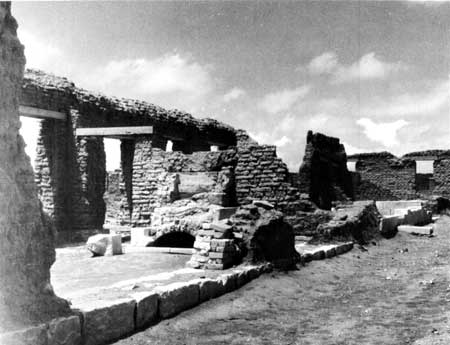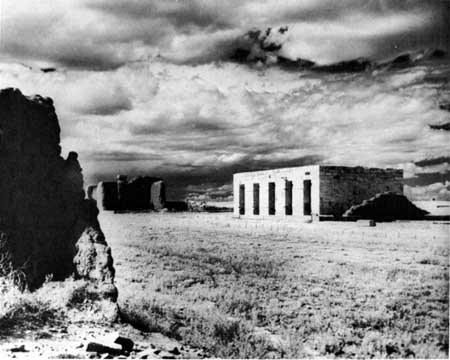|
FORT UNION National Monument |
 |

Blacksmith forge in the Mechanic's Corral.
The Last Years
On Independence Day 1879, the first locomotive of the Atchison, Topeka, and Santa Fe Railroad steamed into Watrous. The railroad ended one era and opened another in the Southwest. For Fort Union the handwriting was on the wall. The Indians had been conquered; as an artery of commerce the Santa Fe Trail had been replaced. Fort Union had outlived its usefulness.
For another 10 years, however, a garrison stagnated at the fort. An occasional chase after desperadoes offered the only field service, social events the only relief from the tedium of garrison life. The buildings continued to deteriorate, and a Quartermaster Department that could see the end in sight consistently refused to authorize repairs.
At least one officer found the life rewarding. Captain Shoemaker, now an Fort Union nearly 30 years, could tell the young West Pointers everything there was to know about the post. "That very courtly old gentleman," wrote the chaplain's daughter many years later, "could not be persuaded to ride on the Santa Fe R. R. . . . and had not been in Las Vegas for many years. He preferred his seclusive life within a certain radius of the Arsenal and the garrison, and was constantly in the saddle, a wonderful horseman even though in his eighties." He finally retired in 1882 after 41 years of service, built a house near the fort, and died 4 years later.

Stone cell block of the military prison, once surrounded by an
adobe building.
In 1890 the War Department decided no abandon all the old frontier posts that no longer served a useful purpose, and Fort Union was included on the list. On February 18, 1891, the Las Vegas Optic reported that "The last few days have told a terrible tale at Fort Union. Four days ago everything was in running order, now everything is upside down and inside our. . . . The soldiers are busy packing government and private property." On the 21st, leaving behind a small caretaker detail, Companies C and H, 10th Infantry, formed on the parade ground and marched down the road to Watrous. Here they boarded a troop train than was to take them to Fort Wingate. Settling in their seats, rifles slung from overhead baggage racks, the infantrymen struck up a song: "There's a Land that is Fairer than This."

|
|
Last Modified: Sat, Sep 28 2002 10:00:00 pm PDT |


